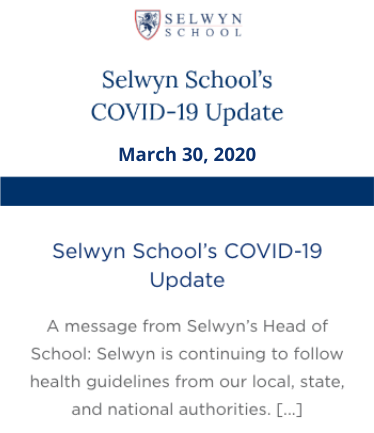
The COVID-19 pandemic disrupted education nationwide. Barely missing a beat, Selwyn developed and launched our distance learning platform, bringing our unique brand of comprehensive, individualized learning to every student from pre-kindergarten to high school.
- Students need both class lessons and individualized attention. Selwyn’s distance learning, perhaps unique among the many virtual education options during this crisis, focuses on both.
- Each class, from preschool through grade 12, opens each morning together to cover planned lessons. Classes are conducted during the day, mindful of recommended limits on screen time. Our students talk with their teachers and each other, a social connection that is so important in these times of social distancing.
- Between classes, our teachers connect with each student to focus on their particular needs. This maintains the individualized education that is a hallmark of the Selwyn experience. It helps tamp down feelings of isolation that can grow during these challenging days. After classes, students congregate informally, keeping their connections alive.
Distance Learning In Action
Coming soon!
Latest Updates:
Selwyn Community Blog
The more time our Selwyn families and team spend at home, the more inspired they become. Take a moment to share your ideas, experiences and inspiration with the Selwyn community!
Parent Guide
From the first day we implemented our distance learning plan, parents need to establish routines and expectations. Distance learning, like in-person schooling, is an full time job. If students don’t give it the proper focus, they can fall behind. Selwyn encourages parents to set regular hours for their children’s school work. Start time is based on the teacher-provided schedule. Keep normal bedtime routines for younger children and expect the same from your MS- and HS-aged children, too. Your children should move regularly and take periodic breaks as they study. It is important that parents set these expectations for how their children will spend their days starting as soon as distance learning is implemented, not several days later after it becomes apparent a child is struggling with the absence of routine.
Your child may have a regular place for doing homework under normal circumstances, but this space may or may not be suitable for an extended period of time, as will be the case if this DLP is implemented. We encourage families to establish a space/location where their children will learn most of the time. This should be a public/family space, not in a child’s bedroom. It should be a place that can be quiet at times and have a strong wireless internet signal, if possible. Above all, it should be a space where parents are present and monitoring their children’s learning when feasible.
Teachers will communicate with parents through email, when and as necessary. The frequency and detail of these communications will be determined by your children’s ages, maturity, and their degree of independence. Selwyn wants parents to contact their children’s teachers. However, we ask parents to remember that teachers will be communicating with dozens of other families, if not 100+, and that communications should be essential, succinct, and self-aware. We also encourage parents to have their children explain the technology systems teachers are using.
Parents are encouraged to start and finish each day with a simple check-in. In the morning, ask what is your child learning today? What are their learning targets or goals? How will they spend their time? What resources do they require? What support do they need? This brief grounding conversation matters. It allows children to process the instructions they’ve received from their teachers. It helps them organize themselves and set priorities. Older students may not want to have these check-ins with parents, but they should nevertheless. Parents should establish these check-ins as regular parts of each day. Not all students thrive in a distance learning environment; some struggle with too much independence or lack of structure. These check-in routines need to be established early, before students fall behind or begin to struggle.
In the course of a regular school day at Selwyn, your son or daughter engages with other students or adults dozens if not hundreds of times. These social interactions and opportunities for mediation include turning to a peer to exchange a thought or idea, participating in small or large group discussions, asking questions for clarification, collaborating on group projects, and countless other moments. While some of these social interactions will be re-created on virtual platforms, others will not. Human beings learn best when they have opportunities to process their learning with others. Beyond the check-ins recommended at the start and end of each day, parents should regularly circle back and engage with their children about what they’re learning. However, it’s important that your child own their work; don’t complete assignments for them, even when they are struggling.
A challenge for families with multiple children will be how to manage all of their children’s needs, especially when those children are different ages and have different needs. There may be times when siblings need to work in different rooms to avoid distraction. Parents may even experiment with noise-cancelling headphones to block out distractions.
Make sure your children remember to move and exercise. This is vitally important to their health, wellbeing, and to their learning. Selwyn’s physical education teachers will recommend activities or exercises, but it is important for parents to model and encourage exercise. Think also about how your children can pitch in more around the house with chores or other responsibilities. Don’t let your children off the hook – expect them to pitch in.
It is imperative for parents to help their children manage the worry, anxiety, and range of emotions they may experience. Difficult though it may be, do your best not to transfer your stress or worry to your children. They will be out of sorts, whether they admit it or not, and need as much normal routine as parents can provide.
Selwyn does not want its students staring at computer screens for 7-8 hours a day. We ask that parents remember most teachers are not experts in distance learning and that it will require some trial-and-error before we find the right balance between online and offline learning experiences. Teachers will periodically check in with you to assess what you’re seeing at home and what we need to adjust. We thank you in advance for your patience and partnership!
There’s always excitement when school closes. The initial excitement of school being closed will fade quickly when students start missing their friends, classmates, and teachers. Help your children maintain contact with friends when circumstances permit. Please also monitor your children’s social media use, especially during an extended school closure. Older students will rely more on social media to communicate with friends. Social media apps such as SnapChat, Instagram, WhatsApp, or Facebook are not official, school-sanctioned channels of communication. Selwyn asks parents to monitor their children’s use of social media. Remind your children to be polite, respectful, and appropriate in their communications and to represent your family’s values in their interactions with others. A student’s written words and tone can sometimes offend or cause harm to others.
For questions about…
- A piece of work, resource, learning activity or class
- A technology-related question or issue
- A personal, academic or social concern
- Other issue related to distance learning
Contact your child’s teacher with questions.
Student Guide
- Establish daily routines for engaging in the learning experiences (start time is based on your teacher)
- Identify a comfortable, quiet space in your home where you can work effectively and successfully
- Complete assignments with integrity and academic honesty, doing your best work
- Communicate proactively with your teachers if you cannot meet deadlines or require additional support
- Collaborate and support your peers in their learning
- Proactively seek out and communicate with other adults at Selwyn as different needs arise (see below)
For questions about…
- A piece of work, resource, learning activity or class
- A technology-related question or issue
- A personal, academic or social concern
- Other issue related to distance learning
Contact your teacher with questions.





